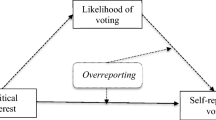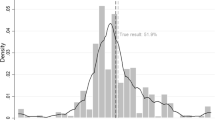Abstract
According to many theoretical accounts of the vote choice, distal determinants (e.g., party identification) influence proximal determinants (e.g., perceptions of candidates), which in turn shape candidate preferences. Yet almost no research on voting has formally tested such mediational hypotheses. Using national survey data collected between February and September of 2004, this paper begins by illustrating how to conduct such investigations. We explored whether public approval of President Bush’s handling of a series of specific national problems (e.g., the Iraq war) influenced overall assessments of his job performance and evaluations of his likely future performance versus John Kerry’s, which in turn shaped vote choices. The results are consistent with the claim of mediation and shed additional light on the impact of various issues on the 2004 election outcome. We also tested what we term the “dosage hypothesis,” derived from news media priming theory, which posits that changes in the amount of media coverage of an issue during the course of a campaign should precipitate changes in the weight citizens place on that issue when evaluating the president’s overall job performance, particularly among citizens most exposed to the news. Surprisingly, this analysis did not yield consistent support for the venerable dosage hypothesis, suggesting that the conditions under which priming occurs should be specified much more precisely in future work.

Similar content being viewed by others
Notes
ABC conducted more pre-election surveys, but we focused on only these five because these were the only questionnaires including the complete set of measures that we needed to allow identical analyses to be conducted at all waves. This permitted us to make over-time comparisons of coefficients for the same equations.
In all waves except 2/10, Ralph Nader was explicitly mentioned. In all waves except 9/23, Nader voters were asked: “If Nader does not run or is not on the ballot, for whom would you vote—Bush or Kerry?” We used responses to this follow-up in constructing our measure of intended vote choice. For the 2/10 wave, ABC News specifically asked a question dealing with a general election contest between Bush and Kerry, making it directly comparable to the questions in later waves. Even though Kerry did not have the requisite number of delegates secured at this point in time, ABC News asked this question because it was evident that Kerry was going to be the nominee based on his victories (often resounding) in 12 of 14 primaries up to that point.
We tested a series of different lags, all of which yielded similar but weaker results. Standard methodology for event analysis is to assume that the event window that produces the most significant difference is the correct one (see Rogerson, 1989), and we did so here.
Variance inflation factors (VIFs) for the regression models in Table 6 vary between 5 and 6, suggesting the presence of multicollinearity. Multicollinearity does not bias coefficient estimates; it only inflates standard errors. But with our large samples, we had considerable power to detect real differences between coefficients. And the replication of similar coefficient patterns across surveys was reassuring about their validity. Most importantly, when we estimated the regression coefficients removing various terms from the equations, our substantive conclusions were consistently sustained, suggesting that our results do not reflect fragile and unstable parameter or significance level estimates. Finally, multicollinearity would not affect the over-time correlations of coefficient estimates and media content, which are presented in Table 8 and discussed below.
Wald tests were used to test linear hypotheses (see Judge, Griffiths, Hill, Lutkepohl, & Lee, 1985, pp. 20–28). The Iraq coefficient was significantly larger than the economy coefficient only in the 5/20 and 9/23 waves (p = .03 and p = .004, respectively). The economy coefficient was significantly larger than the terrorism coefficient only in the 2/10 wave (p = .01).
Other domains (e.g. education, health care) were also asked about in some individual waves. We included only Iraq, the economy, and terrorism to produce across-wave comparability, because these were the three domains asked about in every wave. When we re-estimated the regressions in Table 1 using all possible domains that were asked about, the rank ordering of Iraq, the economy, and terrorism remained unchanged.
The z-statistic assessing across-wave changes in the coefficients β 1 and β 2 was simply calculated by: \( \frac{{\beta _1 - \beta _2 }} {{\sqrt {\text{var} (\beta _1 ) + \text{var} (\beta _2 )} }}.\)
We dichotomized in this fashion to yield two groups of about equal size.
References
Abramowitz, A. I., Lanoue, D. J., & Ramesh, S. (1988). Economic conditions, causal attributions, and political evaluations in the 1984 presidential election. Journal of Politics, 50, 848–863.
Abramowitz, A. I., & Stone, W. J. (2006). The Bush effect: Polarization, turnout, and activism in the 2004 presidential election. Presidential Studies Quarterly, 36, 141–154.
Baron, R. M., & Kenny, D. A. (1986). The moderator-mediator variable distinction in social psychological research: Conceptual, strategic, and statistical considerations. Journal of Personality and Social Psychology, 51, 1173–1182.
Campbell, A., Converse, P. E., Miller, W. E., & Stokes, D. E. (1960). The American voter. New York: Wiley.
Conover, P. J. (1985). The impact of group economic interests on political evaluations. American Politics Quarterly, 13, 139–166.
Domke, D. (2001). Racial cues and political ideology: An examination of associative priming. Communication Research, 28, 772–801.
Domke, D, Shah, D. V., & Wackman, D. B. (1998). Media priming effects: Accessibility, association, and activation. International Journal of Public Opinion Research, 10, 51–74.
Festinger, L. (1957). A theory of cognitive dissonance. Stanford, CA: Stanford University Press.
Fiorina, M. P. (1981). Retrospective voting in American national elections. New Haven, CT: Yale University Press.
Gerber, E. R., & Jackson, J. E. (1993). Endogenous preferences and the study of institutions. American Political Science Review, 87, 639–656.
Gershkoff, A., & Kushner, S. (2005). Shaping public opinion: The 9/11-Iraq connection in the Bush administration’s rhetoric. Perspectives on Politics, 3, 525–537.
Hester, J. B., & Gibson, R. (2003). The economy and second-level agenda setting: A time series analysis of economic news and public opinion about the economy. Journalism & Mass Communication Quarterly, 80, 73–90.
Hetherington, M. J. (1996). The media’s role in forming voters’ national economic evaluations in 1992. American Journal of Political Science, 40, 372–395.
Holbrook, R. A., & Hill, T. G. (2005). Agenda-setting and priming in prime time television: Crime dramas as political cues. Political Communication, 22, 277–295.
Iyengar, S., & Kinder, D. R. (1987). News that matters. Chicago: University of Chicago Press.
Iyengar, S., Kinder, D. R., Peters, M. D., & Krosnick, J. A. (1984). The evening news and presidential evaluations. Journal of Personality and Social Psychology, 46, 778–787.
Iyengar, S., Peters, M. D., & Kinder, D. R. (1982). Experimental demonstrations of the ‘not-So-minimal’ consequences of television news programs. American Political Science Review, 76, 848–858.
Jennings, M. K., & Markus, G. B. (1984). Partisan orientations over the long haul: Results from the three-wave political socialization panel study. American Political Science Review, 78, 1000–1018.
Judge, G. G., Griffiths, W. E., Hill, R. C., Lutkepohl, H., & Lee, T. C. (1985). The theory and practice of econometrics (2nd ed.). New York: John Wiley & Sons.
Kenney, P. J., & Rice, T. W. (1988). Presidential prenomination preferences and candidate evaluations. American Political Science Review, 82, 1309–1319.
Kinder, D. R., Adams, G. S., & Gronke, P. W. (1989). Economics and politics in the 1984 American presidential election. American Journal of Political Science, 33, 491–515.
Kinder, D. R., & Kiewiet, D. R. (1979). Economic discontent and political behavior: The role of personal grievances and collective economic judgments in congressional voting. American Journal of Political Science, 23, 495–527.
Kinder, D. R., & Kiewiet, D. R. (1981). Sociotropic politics: The American case. British Journal of Political Science, 11, 129–161.
Kiousis, S. (2003). Job approval and favorability: The impact of media attention to the Monica Lewinsky scandal on public opinion of President Bill Clinton. Mass Communication & Society, 6, 435–451.
Krosnick, J. A., & Brannon, L. A. (1993). The impact of the gulf war on the ingredients of presidential evaluations: Multidimensional effects of political involvement. American Political Science Review, 87, 963–975.
Krosnick, J. A., & Kinder, D. R. (1990). Altering the foundations of popular support for the president through priming: Reagan and the Iran-contra affair. American Political Science Review, 84, 495–512.
Langer, G. E., & Merkle, D. M. (2006). ABC news’ polling methodology and standards. http://abcnews.go.com/US/PollVault/story?id=145373&page=1 (June 9, 2006).
Lavrakas, P. J. (1993). Telephone survey methods: Sampling, selection, and supervision. Thousand Oaks, CA: Sage.
Lodge, M., McGraw, K. M., & Stroh, P. (1989). An impression-driven model of candidate evaluation. American Political Science Review, 83, 399–419.
MacKinnon, D. P., Lockwood, C. M., & Williams, J. (2004). Confidence limits for the indirect effect: Distribution of the product and resampling methods. Multivariate Behavioral Research, 39, 99–128.
Markus, G. B., & Converse, P. E. (1979). A dynamic simultaneous equation model of electoral choice. American Political Science Review, 73, 1055–1070.
Miller, J. M. (2004). Media agenda-setting: Does content matter? Presented at the annual meeting of the Midwest Political Science Association, Chicago, IL.
Miller, J. M., & Krosnick, J. A. (2000). News media impact on the ingredients of presidential evaluations: Politically knowledgeable citizens are guided by a trusted source. American Journal of Political Science, 44, 295–309.
Murdoch, M., Van Ryn, M., Hodges, J., & Cowper, D. (2005). Mitigating effect of department of veterans affairs disability benefits for post-traumatic stress disorder on low income. Military Medicine, 170, 137–140.
Needham, B. L., & Crosnoe, R. (2005). Overweight status and depressive symptoms during adolescence. Journal of Adolescent Health, 36, 48–55.
Page, B. I., & Jones, C. C. (1979). Reciprocal effects of policy preferences, party loyalties, and the vote. American Political Science Review, 73, 1071–1089.
Patterson, T. E. (2005). Young voters and the 2004 election. Report, Joan Shorenstein Center on the Press, Politics, and Public Policy.
Pew Research Center for People and the Press. (2004). Voters more engaged, but campaign gets lukewarm ratings. Survey report.
Rogerson, W. P. (1989). Profit regulation of defense contractors and prizes for innovation. Journal of Political Economy, 97, 1284–1305.
Shrout, P. E., & Bolger, N. (2002). Mediation in experimental and nonexperimental studies: New procedures and recommendations. Psychological Methods, 7, 422–445.
Sobel, M. E. (1982). Asymptotic confidence intervals for indirect effects in structural equation models. Sociological Methodology, 13, 290–303.
Stoker, L. (1993). Judging presidential character: The demise of Gary Hart. Political Behavior, 15, 193–223.
Thorndike, E. L. (1920). A constant error on psychological rating. Journal of Applied Psychology, 4, 25–29.
Valentino, N. A., Hutchings, V. L., & White, I. K. (2002). Cues that matter: How political ads prime racial attitudes during campaigns. American Political Science Review, 96(1), 75–90.
Wattenberg, M. P. (2005). Turnout in the 2004 presidential election. Presidential Studies Quarterly, 35, 138–146.
Zamboanga, B. L., Bean, J. L., Pietras, A. C., & Pabon, L. C. (2005). Subjective evaluations of alcohol expectancies and their relevance to drinking game involvement in female college students. Journal of Adolescent Health, 37, 77–80.
Acknowledgment
We thank Gary Langer, Dan Merkle, and Jon Cohen of ABC News for sharing these data with us and for their helpful comments on the manuscript. Jon Krosnick is University Fellow at Resources for the Future.
Author information
Authors and Affiliations
Corresponding author
Additional information
Jon Krosnick is a University Fellow at Resources for the Future, Washington, DC, USA.
Rights and permissions
About this article
Cite this article
Malhotra, N., Krosnick, J.A. Retrospective and Prospective Performance Assessments during the 2004 Election Campaign: Tests of Mediation and News Media Priming. Polit Behav 29, 249–278 (2007). https://doi.org/10.1007/s11109-007-9027-8
Received:
Accepted:
Published:
Issue Date:
DOI: https://doi.org/10.1007/s11109-007-9027-8




